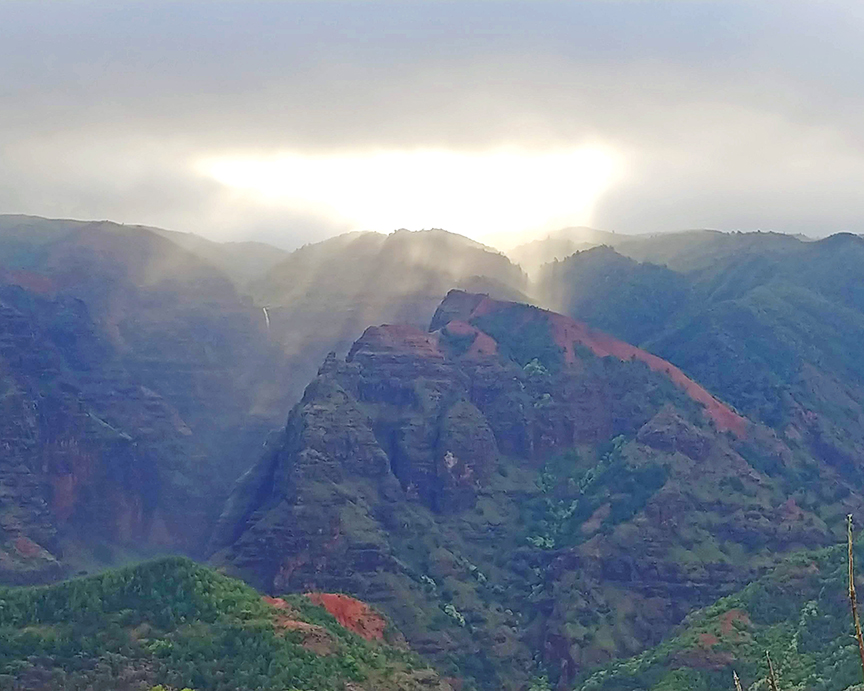By Uma Sivanathan

Kaua‘i shows its beauty every day to each of us, such as this golden sunset at Kalapaki Beach. Sometimes we just need a friend or a relative to help us to see the beautiful and positive things right in front of us. Photo by Léo Azambuja
Crystal meth, also known as “ice,” is a colorless, smokable form of d-methamphetamine. It resembles glass fragments or ice shavings. Meth is highly addictive and is the most powerful stimulant drug.
“The defining feature of addiction to meth, is that the addicted individual keeps on taking the drug despite the negative health and social effects of doing so,” states drugabuse.gov.
The use of meth knows no social or economic boundaries. Alan Johnson, CEO of Hina Mauka Treatment Center explains; “We are a population where we have two jobs and people are working really hard. We have a lot of single parent families. Meth does give you energy. Some people are using meth at first to manage their lives.”
Dr. James Bjork of the National Institute on Drug Abuse explains the effect of meth on the brain is a double whammy because the part of the brain that normally controls risky behavior does not function properly, while the habit-sustaining center is chemically beefed up and on overdrive. Meth also diminishes the user’s ability to suppress or control aggressive behavior.
Dr. Bjork strongly advocates for education of community members on the potential long-term harm meth can do to our brains, bodies, and innocent babies in the womb of a drug user.
I recommend viewing the comprehensive, highly effective peer-to-peer outreach of the Montana Meth Project with their “Ask? Me.” campaign on Facebook.
Georgianna DeCosta, who was with the Hawai‘i Meth Project for several years, uses her personal story of addiction to warn about the dangers of crystal meth; “Meth changes people in a different way. It really does destroy people’s mind, body and soul. And I mean that in the deepest depths of the person’s being.”
A big factor in prevention of meth addiction is not allowing crystal meth to come onto Kaua‘i’s shores. We, as community members, can support the Kaua‘i Police Department in this endeavor. Last year, in a single sweep, KPD seized $1.6 million worth of meth and arrested two suspects in a drug-trafficking organization.
For those community members who are struggling with drug addiction, or are a family member or a friend of a user, monthly community meetings are being hosted by the Mayor’s Advisory Committee for Treatment and Community Integration. The meetings are being held at the Kapa‘a Missionary Church at 4-758 Kuhio Hwy., directly across Kapa‘a Foodland. The intention of the meetings is to provide a safe, non-judgmental place to talk story, voice concerns and discuss ways to address drug addiction on Kaua‘i. The next meeting is Aug. 15. Contact Brian Kohatsu at 482-2366 for more information.

Uma Sivanathan
Also, there are many services for treatment and recovery listed in the Resource Directory on the Life’s Choices website at www.kauai.gov/lifeschoiceskauai.
In closing, I ask that our island community support the building of the Adolescent Treatment and Healing Center in Hanama‘ulu. The Center would serve our youth who are struggling with drug or alcohol addiction, keeping them on Kaua‘i, so they can be close to their families during their healing process.
With love for all of our island community,
Uma Sivanathan
- Uma Sivanathan is the founder and president of Mana‘olana Center For Health and Healing. She can be reached @manaolanacenter@gmail.com
Discover more from For Kauai Online
Subscribe to get the latest posts to your email.






Leave a Reply